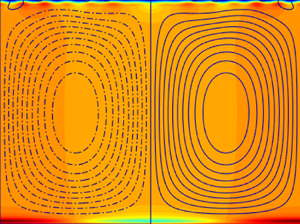Article contents
Penetrative convection: heat transport with marginal stability assumption
Published online by Cambridge University Press: 05 April 2023
Abstract

This paper investigates heat transport in penetrative convection with a marginally stable temporal-horizontal-averaged field or background field. Assuming that the background field is steady and is stabilised by the nonlinear perturbation terms, we obtain an eigenvalue problem with an unknown background temperature  $\tau$ by truncating the nonlinear terms. Using a piecewise profile for
$\tau$ by truncating the nonlinear terms. Using a piecewise profile for  $\tau$, we derived an analytical scaling law for heat transport in penetrative convection as
$\tau$, we derived an analytical scaling law for heat transport in penetrative convection as  $Ra\rightarrow \infty$:
$Ra\rightarrow \infty$:  $Nu=(1/8)(1-T_M)^{5/3}Ra^{1/3}$ (
$Nu=(1/8)(1-T_M)^{5/3}Ra^{1/3}$ ( $Nu$ is the Nusselt number;
$Nu$ is the Nusselt number;  $Ra$ is the Rayleigh number and
$Ra$ is the Rayleigh number and  $T_M$ corresponds to the temperature at which the density is maximal). A conditional lower bound on
$T_M$ corresponds to the temperature at which the density is maximal). A conditional lower bound on  $Nu$, under the marginal stability assumption, is then derived from a variational problem. All the solutions to the full system should deliver a higher heat flux than the lower bound if they satisfy the marginal stability assumption. However, data from the present direct numerical simulations and previous optimal steady solutions by Ding & Wu (J. Fluid Mech., vol. 920, 2021, A48) exhibit smaller
$Nu$, under the marginal stability assumption, is then derived from a variational problem. All the solutions to the full system should deliver a higher heat flux than the lower bound if they satisfy the marginal stability assumption. However, data from the present direct numerical simulations and previous optimal steady solutions by Ding & Wu (J. Fluid Mech., vol. 920, 2021, A48) exhibit smaller  $Nu$ than the lower bound at large
$Nu$ than the lower bound at large  $Ra$, indicating that these averaged fields are over-stabilised by the nonlinear terms. To incorporate a more physically plausible constraint to bound heat transport, an alternative approach, i.e. the quasilinear approach is invoked which delivers the highest heat transport and agrees well with Veronis's assumption, i.e.
$Ra$, indicating that these averaged fields are over-stabilised by the nonlinear terms. To incorporate a more physically plausible constraint to bound heat transport, an alternative approach, i.e. the quasilinear approach is invoked which delivers the highest heat transport and agrees well with Veronis's assumption, i.e.  $Nu\sim Ra^{1/3}$ (Astrophys. J., vol. 137, 1963, p. 641). Interestingly, the background temperature
$Nu\sim Ra^{1/3}$ (Astrophys. J., vol. 137, 1963, p. 641). Interestingly, the background temperature  $\tau$ yielded by the quasilinear approach can be non-unique when instability is subcritical.
$\tau$ yielded by the quasilinear approach can be non-unique when instability is subcritical.
- Type
- JFM Papers
- Information
- Copyright
- © The Author(s), 2023. Published by Cambridge University Press
References
- 3
- Cited by





